-
TrackoBit
Manage commercial vehicles with the new-age Fleet Management Software
TrackoBit -
TrackoField
Streamline your scattered workforce with Field Force Management Software
TrackoField -
Features Resources
-
Blog
Carefully curated articles to update you on industrial trends. -
White Paper
Insightful papers and analysis on essential subject matters. -
Glossary
Explore an alphabetical list of relevant industry terms. -
What’s New
Get TrackoBit & TrackoField monthly updates here. -
Case Study
Explore the cases we solved with our diverse solutions. -
Comparisons
Compare platforms, features, and pricing to find your best fit.
-
About Us
Get to know TrackoBit: our team, ethos, values, and vision. -
Careers
Join the most dynamic cult of coders, creatives and changemakers. -
Tech Support
Learn about our technical support team and services in detail. -
Events
Check out the exhibitions where we left our marks and conquered. -
Contact Us
Connect with us and let us know how we can be of service.
How Does A Modern Employee Leave Management System Resolve HR Managers’ Challenges?
- Author:Shivani Singh
- Read Time:6 min
- Published:
- Last Update: March 21, 2025
Table of Contents
Toggle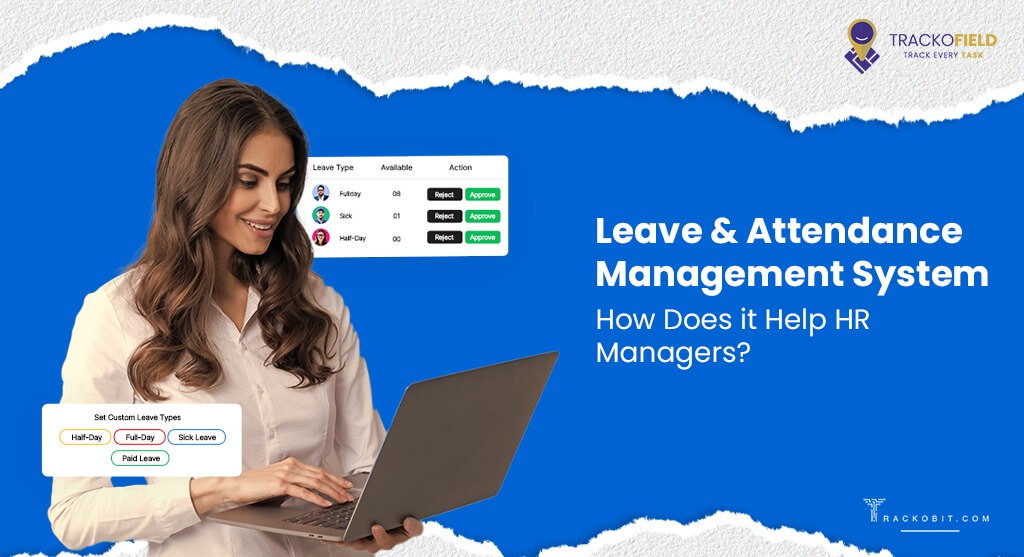
Learn how a comprehensive employee leave management system helps you avoid leave management challenges plagued by outdated tools, traditional methods, and spreadsheets.
Table of Contents
Toggle
HR jobs are not easy, especially in an organization, where conventional leave management methods are followed. They have to go through a maze of email chains and spreadsheets while.
- Tracking employees’ leave records on different channels.
- Assessing attendance patterns and trends.
- Calculating employees’ total working hours for payroll disbursement.
Consequently, it leads to disturbance in administrative tasks and messed up employees’ leave balance. But, don’t worry, managing employees’ leaves will become as easy as ABC when you upgrade to automated employee leave management methods. Here is how the automated employee leave management system reduces pitfalls associated with manual leave tracking and lifts HR managers’ burden.
Challenges Associated with Manual Leave & Attendance Management System
Leave management includes tracking all aspects of employees’ leaves be it casual, vacation, sick, etc., and a single error in the process leads to inaccurate payouts and lower employee satisfaction. Here are all the challenges faced by HR in LMS when done manually that make employee leave management a herculean task.
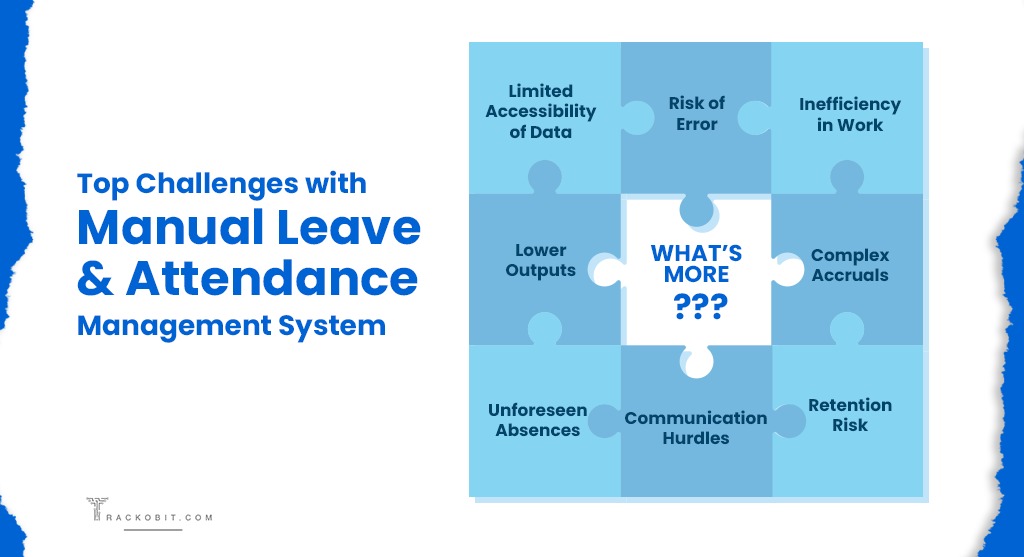
1. Communication Hurdles
Not having a centralized leave and attendance management system leads to communication hurdles. HR personnel cannot simply detect the status of pending requests on time. Moreover, they are required to transmit the leave documents to all line managers via different channels like WhatsApp, Email, Personal Chat, etc. This causes document vulnerability and delays in notifying employees about leave approval and denial.
2. Limited Accessibility of Data
HRs have all leave-related data with them on their systems in silos. In siloed management, communication and leave data become fragmented. It also prevents managers from handling leave requests remotely. They have to visit their 3-4 scattered offices to access systems and tackle employees’ leave-related tasks. This only makes leave management a bit more complex.
3. Inefficiency in Work
As the volume of leave requests increases, HR managers may find it really agitating to keep up with the ongoing work. Additionally, they repeat the whole procedure when an employee changes the data, cancels the leave, or takes short leaves/unforeseen holidays. This brings unnecessary workloads to HR managers, and they cannot focus on their other tasks.
4. Risk of Error
Miscalculating, misinterpreting, and overseeing employees’ leaves lead to inaccurate leave balances, which are further shared with the finance team to process and disburse payroll to employees. This results in discrepancies in payroll, salary computation, and employee dissatisfaction which may further lead to legal conflicts.
5. Lower Outputs
Organizations with a substantial workforce consume a lot of their working hours in leave tracking and number crunching. On top of that, a sudden influx of leave requests overwhelms the situation. Consistent ignorance to leave requests deteriorates employees’ morale and they translate it into lower work efficiency and output.
6. Unforeseen Absences
HR managers cannot simply assess unforeseen absences with manual leave and attendance management systems. Lacking this leads to short-staffed departments, disrupted work schedules, and underutilized resources. Moreover, the quality of work could suffer when there are not adequate resources to manage the ongoing task.
7. Retention Risk
Constant leave rejection and delays in leave acknowledgment increase interpersonal conflicts within the workplace. Being already disturbed by unresolved leave requests, employees cover for their absent colleagues. This compels them to look for better employment opportunities and organizations struggle with retention risk.
8. Complex Accruals
The manual calculation gets complex when an organization follows varied accrual rates and leave policies. It makes the leave management process a lot more laborious. Thus, compelling HR managers put in their blood, sweat, & tears to derive a conclusion.
How Does an Employee Leave Management System Overcome Challenges?
A leave and attendance management system (LMS) seamlessly automates all stages of the leave management process, i.e., application, approval/rejection, filing leaves, managing leave balance, and analysis.
More than that, it eliminates the use of a bunch of spreadsheets to let managers smoothly handle multiple leave plans. They get control over complicated leave-related tasks and overcome challenges with its offerings like:
1. Dashboard Consolidation
Managers can get a high level view of leave-related data, i.e., employees’ leave balance, leave requests, holiday lists, etc. Meanwhile, employees can apply for leave, check the status of their leave requests, and assess how many leaves they are left with over a consolidated dashboard.
2. Cloud-based Solution
Cloud-based leave & attendance management systems allow managers to track their employees’ time and attendance in multiple ways. For instance, they can use web-based apps to manage employees’ leaves when they work remotely, or biometric or ID card systems when they are in the office. Not to mention, cloud-based solutions also allow employees to request time off from anywhere.
3. Auto-update Leave Balance
HR Managers are no longer required to compute and update employees’ remaining leave balances manually. The leave & attendance management software automatically does it after managers accept the leave requests. HR’s role is reduced to only acknowledging those leave requests, letting them focus on other key activities.
4. Effortless Integration
LMS also eliminates the tedious task of calculating employees’ payouts when integrated with a payroll management system. The entire range of functions entailed in these two processes such as working hours compilation, salary computation, payroll reports generation, etc. get all automated. Thus, leaving no room for manual efforts and errors.
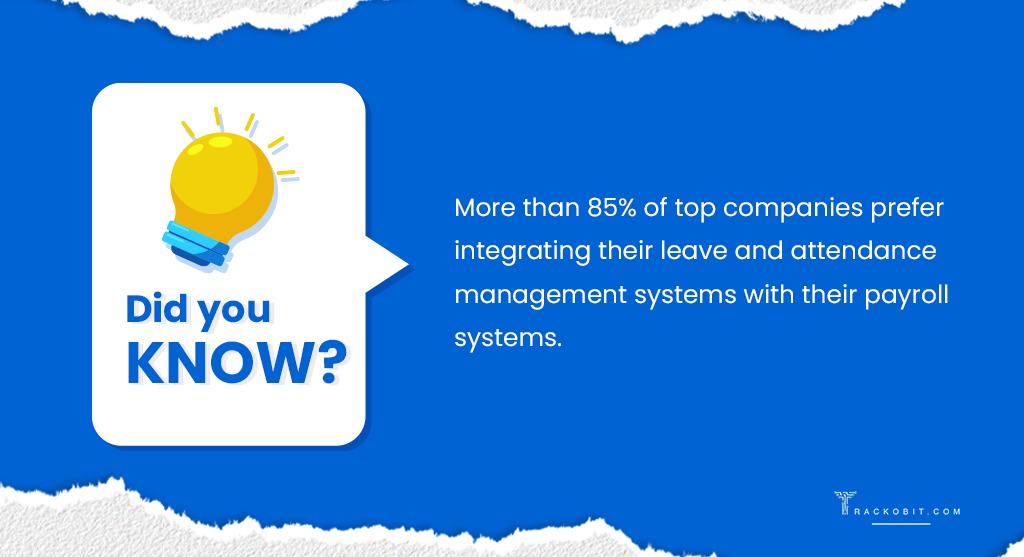
5. Reporting Simplicity
Who does not want in-depth details on employees’ leaves to evaluate the intricacies of absenteeism trends and patterns? Well, this is easily attainable with the employee leave management system. The software provides reports on employees’ leaves, time-offs, breaks, vacations, etc. So, without any scope of grievance, you can access and analyze the relevant data you need.
6. Real-time Supervision
Leave and attendance management systems consist of GPS technology that helps HR managers get surveillance over their employees when they are out for jobs. That means employees cannot manipulate their working hours and leave. Real-time supervision provides managers with employees’ on-duty and actual working hours. They can assess this information to validate if employees are actually working or not.
Role of TrackoField as Leave & Attendance Management Software
TrackoField helps employees process easier leave applications and provides managers with instant notification upon receiving requests. Here is a step-by-step procedure on how Track0Field documents every interaction (email, phone call, or meeting) about employees’ leaves on a centralized platform and lets HR managers enjoy employee leave management system.
Step 1: Employees access their mobile apps to request a day off.
Step 2: All line managers get alerts and notifications to provide their approvals.
Step 3: Upon managers providing their acceptance or denial, the system auto-updates employees’ leave balance.
Step 4: When integrated with payroll software, TrackoField syncs data on employees’ leave and attendance to process payouts to employees.
To Sum it Up!
Ensuring employees’ leave requests get acknowledged on time is crucial for employee satisfaction and retention. With the system in place, you can quit the spreadsheet dependency, eliminate administrative tasks, and automate the entire procedure of leave request submission and acknowledgement.
Want to learn more?
Sign up to use TrackoField, employee leave management automation software for free. The software has a flexible leave module, live workforce monitoring, auto-updated leave balance, insightful dashboard, etc., making you smoothly manage your employees’ leaves.
FAQs
-
What are the significant challenges associated with a Manual Attendance & Leave Management System?
Here is a list of challenges HR managers face while tracking and operating employees’ leaves. - Vulnerable Documents - Communication Hurdles - Inefficiency in Work - Limited Accessibility of Data - Unforeseen Absences - Complex Accruals - Retention Risk
-
What modern solutions should HR use to track employees’ attendance?
Discover the list of solutions that you can access and run for attendance tracking. - Time and Attendance tracking software to manage PTO requests and automate timekeeping. - Biometric app support to let employees mark their attendance via their mobile phones after placing their fingertips. - Cloud-based solutions that ensure seamless integration with your existing payroll process and take care of data security.
-
How can the leave and attendance management system help HR managers?
Leave and attendance management system provides HR managers with - Dashboard consolidation - Effortless integration with payroll and expense software - Real-time supervision ensured by GPS technology - Reporting facility on employees’ time off - Auto-updated leave balance. All these make leave management a simpler process.
-
What is the importance of leave management?
Leave management is vital to assess employees’ actual working hours for accurate payroll processing and disbursement.
Shivani is a Content Specialist working for TrackoField. She comes with years of experience writing, editing and reviewing content for software products. Her underlining expertise in SaaS especially H... Read More
Related Blogs
-

How MFIs Are Working In Modern Day Scenario? A Complete Breakdown
Mudit Chhikara December 30, 2025How field force automation is helping MFIs transform field operations.
-
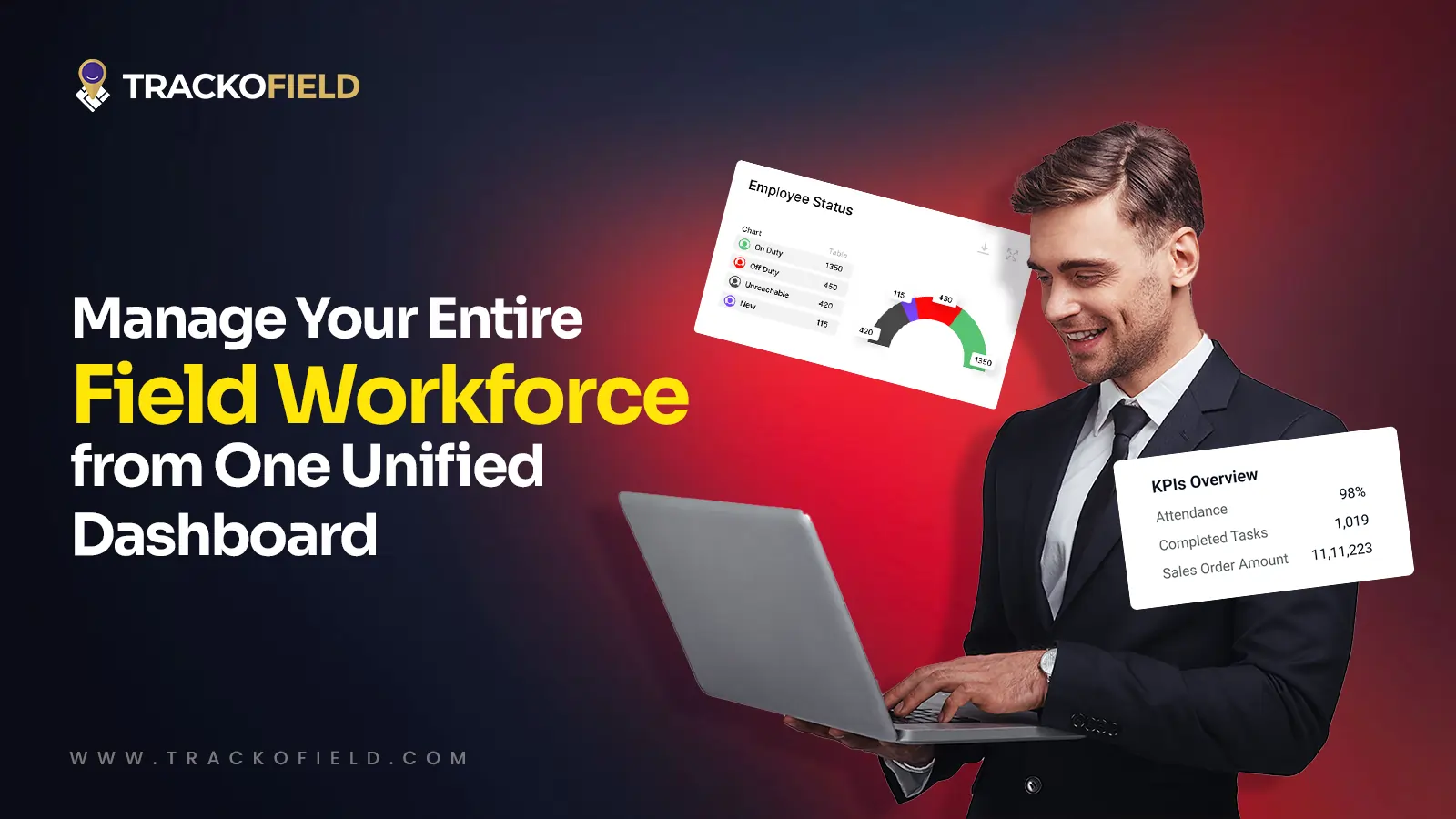
Unified Field Workforce Dashboard: Monitor Tasks, Attendance & More In One Place
Mudit Chhikara December 15, 2025Bring full clarity to field operations with a single, real-time field workforce dashboard.
-

Loan Disbursement in NBFCs: From 15 Days to 3 Minutes – Learn How
Shemanti Ghosh December 11, 2025TrackoField’s AI-enabled field force automation software speeds up loan disbursals in NBFC with field agent task monitoring and facial attendance…
-
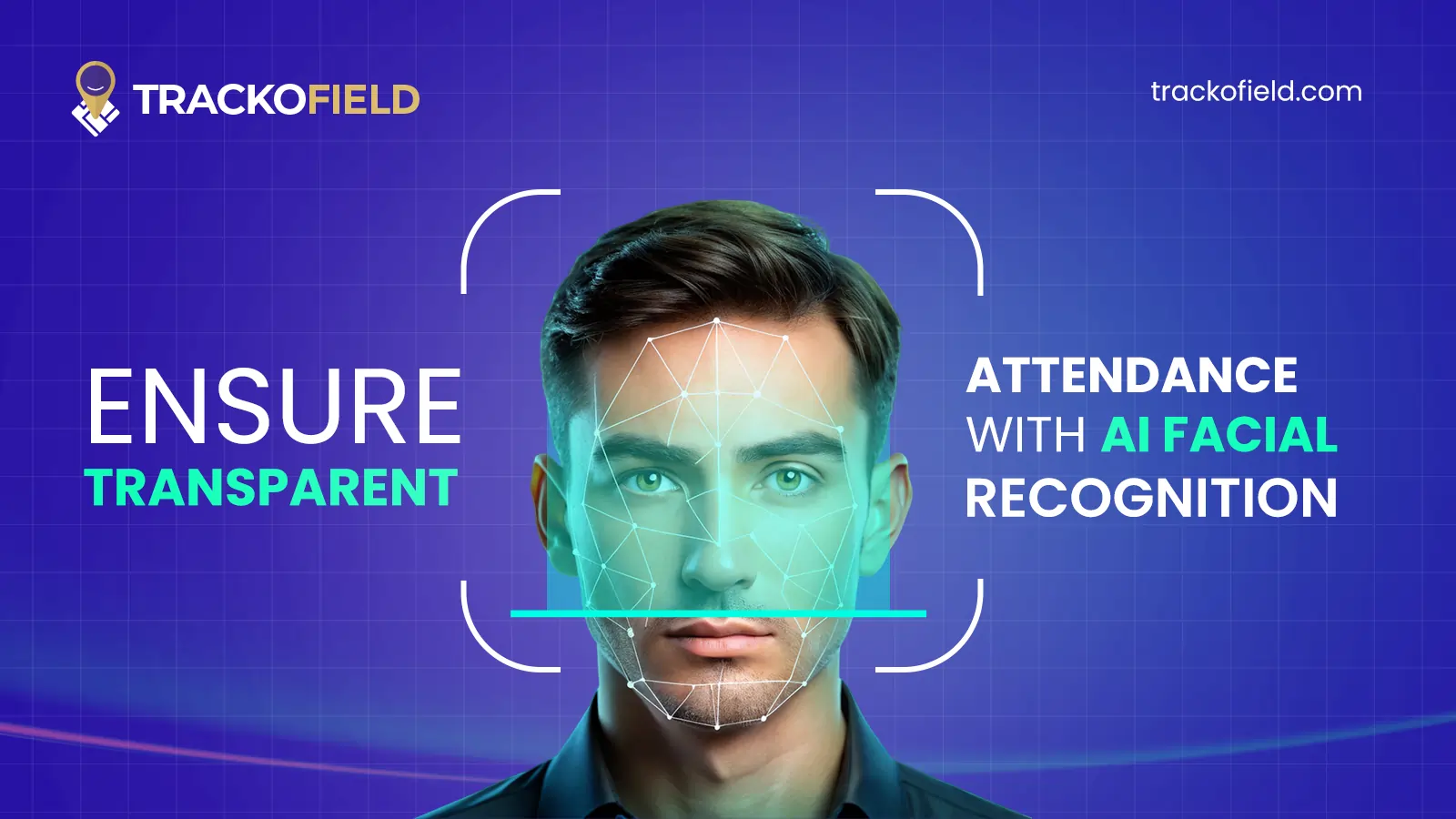
AI Facial Recognition Attendance: A Game-Changer for Fraud-Free Field Operations
Mudit Chhikara December 9, 2025Ensure transparent attendance and eliminate fraud before it even starts with AI facial recognition and geofencing.

Subscribe for weekly strategies to boost field team productivity.
Your inbox awaits a welcome email. Stay tuned for the latest blog updates & expert insights.
"While you're here, dive into some more reads or grab quick bites from our social platforms!"Stay Updated on tech, telematics and mobility. Don't miss out on the latest in the industry.
We use cookies to enhance and personalize your browsing experience. By continuing to use our website, you agree to our Privacy Policy.



































